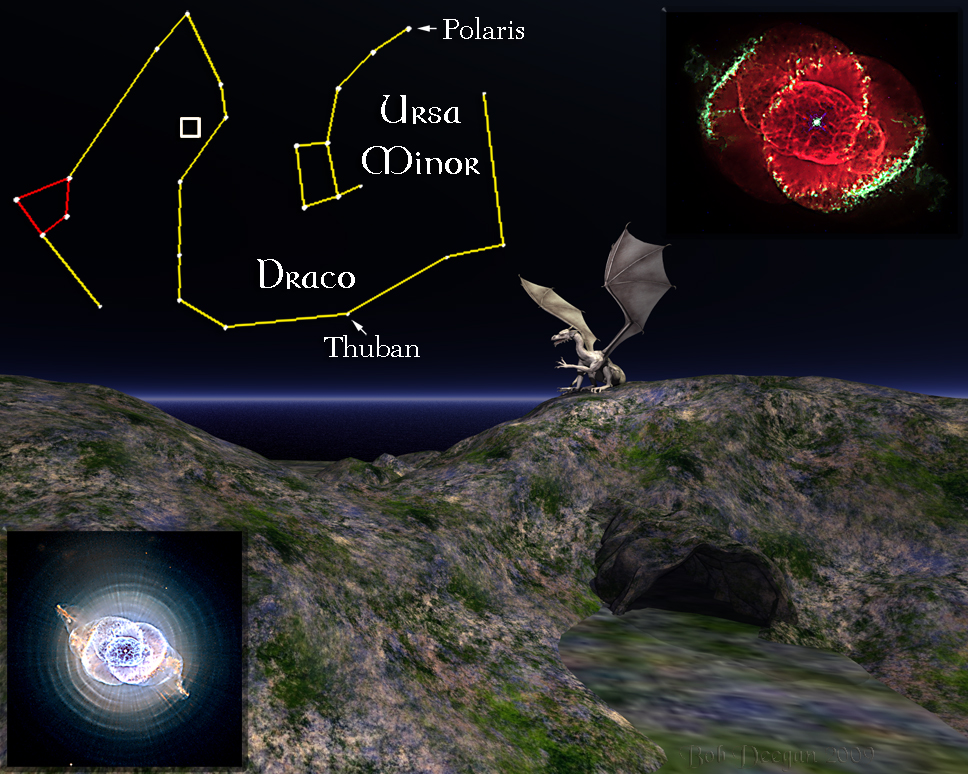
For the week including November 27, 2009

THE DRAGON
One of the oldest known constellations, Draco, the Dragon has been around since the star maps of the ancient Babylonians and Sumerians. Because most of the Dragon’s stars are pretty faint, it can be a little difficult to spot among the other stars that make up the northern sky.
To start the search, face toward the horizon where the Sun went down, and then turn right. You’re now facing north. To locate the constellation of the Dragon, we can start at Polaris, the North Star. Polaris marks the end of the handle of the Little Dipper which is also the constellation of Ursa Minor, the Lesser Bear. Polaris isn’t very luminous, but it’s a good deal brighter than any nearby. Winding around Ursa Minor are the faint stars of Draco’s tail; follow them along to the left and you will come to the four prominent stars that mark the Dragon’s head. Once you’ve found Draco, you’ll have no trouble pinpointing its stars again. The serpentine trail of its stars is distinctive in the sky. The Dragon used to be home to the “North Star” when the ancient Egyptians were building their magnificent pyramids. Thuban lost this distinction because of a slow wobble in the Earth’s rotation called precession. As our planet gradually totters through the 26,000 years of its precession, our North Pole gets pointed towards other areas of space and we get new Pole stars to help us find our way. It will take some 21,000 years before Thuban will regain the title of Pole Star.
The Cat’s Eye Nebula: Stars are enormous nuclear furnaces. During the course of their lifetime, the heat and light they give off are produced by the conversion of lighter elements, like hydrogen, into heavier elements, like helium. When it nears the end of its lifespan, a star like our Sun begins to run out of nuclear fuel and undergoes a slow “death”. Its color deepens, becoming a deep and ruddy red. In a string of pulsations, it increases its size dramatically, becoming a giant. Eventually, out of fuel, the core of the star collapses, becoming a hot white dwarf. The outer layers of the star are puffed away into space, to form a glowing nebula or cloud.
The Cat’s Eye, the first star astronomers caught undergoing this process, is shown in the accompanying Hubble Space Telescope photographs. At lower left, in our illustration, we see the star in its final stages, sloughing off its outer layers in a series of gradual eruptions. The concentric shells of material visible in the photo appear to have expanded away from the star’s surface at intervals of 1,500 years. About one thousand years ago, a violent, and so far unidentified, upheaval occurred that created the structures shown in detail at upper right. The debris is made to glow by ultraviolet radiation emanating from the hot core of the central star. Studies of the Cat’s Eye in the 1860’s gave us our first understandings of the properties of stars other than our Sun. Science has come a long way since then and this star is still providing clues to the unanswered questions that remain regarding the processes of stellar evolution.
Unless otherwise indicated, all content of this web site is the copyright of Robert Deegan and all rights are reserved.
For more information, or to comment, please contact: Bob@NightSkies.org